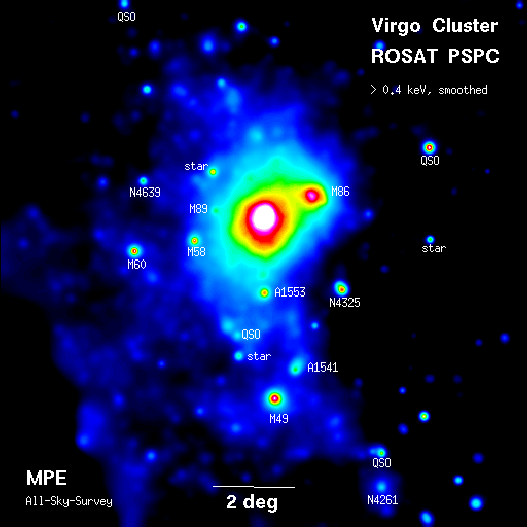ASCA Special Exhibit
Abundances of elements in clusters of galaxies
Our universe started with only hydrogen, helium, and trace amounts of other elements. However, we live on a world full of those other elements. How have carbon, oxygen, and other elements been created and distributed throughout cosmic time?
This is one of the most fundamental questions in astrophysics, touching on the origin of the Earth and life as we know it. It is generally agreed that hydrogen and helium formed shortly after the Big Bang, when the universe was hot; all other elements were created in stars, and distributed by supernova explosions. However, we still have a lot to learn of the details of the chemical evolution (how much of different elements was created and how far these propagated to different places at different times in the history of the universe). One particular question is the relative importance of two types of supernovae, type I and type II, at different times. ASCA observations of clusters of galaxies have provided a valuable clue for this continuing study.

The Virgo Cluster of galaxies in X-ray light. (Credit: B&oulm;hringer, H. et al. Max Planck Institute for Extraterrestrial Physics)
Clusters of galaxies are filled with X-ray emitting hot gas. The gas is 'enriched' with carbon, oxygen, and other elements due to supernova explosions in the member galaxies, but, due to the large distances involved, reflects the early conditions in the history of the universe. Since the condition of this gas is simple (unlike in accreting binaries), the abundances of elements can be estimated by measuring the strengths of the characteristic lines of these elements.
Before ASCA, it was known that the hot gas in clusters had more iron than was predicted by the standard model of supernovae. It was impossible to tell which was under-predicted in the model, the number of Type I supernovae or that of Type II supernovae. Type II supernovae are how stars much more massive than the Sun end their lives; Type I are thought to be accreting white dwarfs. The two types produce different elements in different proportions, which ASCA was able to measure. Because the pattern of abundances of the hot cluster gas matches those produced by Type II supernovae, ASCA told us that the extra supernovae that were previously not predicted were of Type II. This in turn implies that there were more massive stars in the early universe than previously thought.
Published: February 1998
Text Reviewed: September 2018


